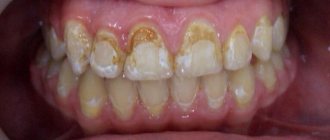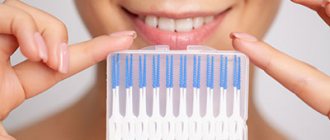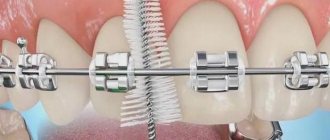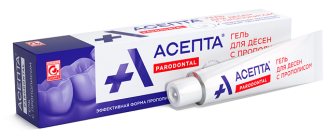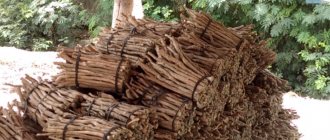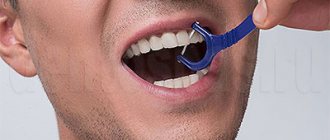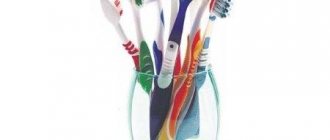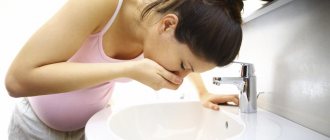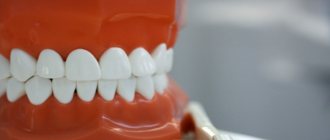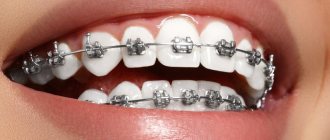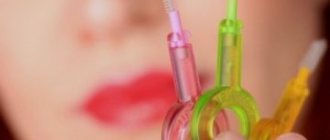How often do we think about whether we brush our teeth correctly? Of course not. Only after visiting a dentist can we analyze the results of our hygiene based on the condition of our oral cavity and draw up a treatment plan. And it turns out that there are not only rules for brushing teeth, but many scientific dentists have come up with various methods of brushing teeth. Methods for brushing teeth have been invented since 1922 (for example, the Charter method). There are many modern methods of brushing teeth. For example, the method of Bass, Leonardo, Fones, etc. I think it is reasonable if the patient manages to master the usual standard method of brushing his teeth and carefully monitor its implementation in practice.
Standard method of brushing teeth
The dentition is conventionally divided into several segments: large molars, small molars and anterior teeth on each side. (it turns out 4-6 segments). Teeth brushing is carried out with open dentition. The toothbrush is placed at an angle of 45 degrees to the surface of the tooth.
They begin to brush their teeth from the buccal surface of the upper jaw on the left (segment 1), where they perform 10 sweeping movements with the brush, after which they gradually move through all other segments, making 10 movements for each segment.
Next, they clean the palatal surface of the upper teeth, passing through the segments from left to right, making 10 sweeping movements on each segment.
The next stage of teeth cleaning is cleaning the chewing surface of the large and small molars. Cleaning is carried out with horizontal movements along their chewing surface. It is necessary to make 10-15 movements on each side.
On the lower jaw, teeth are brushed in the same sequence. First on the buccal, and then on the lingual and finally on the chewing surface of the teeth.
When cleaning the palatal surface of the upper incisors and the lingual surface of the lower teeth, the brush is positioned perpendicular to the dentition. The cleaning procedure should end with a massage of the gums, which is carried out with closed dentition using circular movements of the brush, capturing the teeth and gums of all segments.
How to brush your teeth correctly?
There are other methods of brushing teeth: the Leonard method, the Reite method, the Bass method, the Smith-Bell method, the Stillman method, the Fones method, the Charter method. Each of these methods is selected taking into account the condition of the teeth and periodontium. For example, for gingivitis during puberty, it is recommended to use gentle teeth brushing techniques, which include the Charter and Bass method.
How to brush your teeth - The Charter Method
The method is used to clean teeth and gums, and to massage the gums. In this case, the toothbrush is positioned so that the bristles are at an angle of 45 degrees to the gingival margin. Without removing the bristles, perform gentle shaking or circular movements, while the bristles penetrate between the teeth.
How to brush your teeth - Bass Method
The brush is placed at an angle of 45 degrees to the tooth axis, their ends partially penetrate the gingival groove and interdental spaces. The brush moves vibrating forward and backward.
These two methods help clean the gingival grooves, interdental spaces and contact surfaces of the teeth.
How to brush your teeth - The Leonard Method
It is performed using a brush, which is placed perpendicular to the surface of the teeth, making only perpendicular movements in the direction from the gums to the crown.
How to brush your teeth - Reite Method
With the Reite method, the bristles are placed parallel to the axis of the tooth, performing rolling movements from the gums to the crown.
How to brush your teeth - Smith-Bell Method
With this method of brushing teeth, the movements of the brush follow the path of food during chewing. The brush is placed perpendicular to the chewing surface and in this position, with gentle pressure and rotation, is advanced to the gum.
How to brush your teeth - The Stillman Method
The method is performed by pressing on the gingival margin with a brush using weak rotational movements. The bristles are installed so that their ends partially lie at an angle to the axis of the tooth, and partially on the gum.
How to use an electric toothbrush
Believe it or not, many schoolchildren are now excited about brushing their teeth, a daily dental care ritual. We can thank the invention of the electric toothbrush for this phenomenon.
Electric brushes are easy to use, and this is one of their advantages. And although an electric toothbrush costs more than a regular toothbrush, it is worth it if your child (or you) is more enthusiastic about using it for oral health, as it can improve your oral health. Most electric toothbrushes work anywhere from 5,000 to 30,000 strokes per minute, and because of this, a thorough brushing takes less time. Some electric toothbrushes are even more powerful - Oral B's Professional Care 7000 series rotates 40,000 times per minute.
To learn more…
To use an electric toothbrush, simply squeeze a little toothpaste onto the brush head and hold it at a 45-degree angle, just like a regular brush. Then turn on the brush and move the bristles from tooth to tooth. Typically, small brush heads clean one tooth at a time, depending on the size of your teeth. Guide the brush along the front, back, and chewing surfaces of each tooth. Even with an electric toothbrush, you'll have to spend about two minutes brushing to make sure you've brushed every tooth. After cleaning, simply rinse the attachment with water and let it dry.
People with healthy periodontal disease are recommended to brush their teeth using the standard brushing method twice a day (in the morning after breakfast and at night). With the standard method of brushing teeth, the dentition is conventionally divided into 6 segments (molar group, premolar group and frontal group). Teeth begin to be brushed from the left molars of the upper jaw towards the center. First on the upper jaw, then on the lower jaw. The dentition is open.
Algorithm for the standard method of brushing teeth 1. Divide the dentition into several segments: molars, premolars, front teeth. 2. Place the brush at an angle of 45 degrees to the surface of the teeth (dentitions are open). 3. Brush the teeth from the vestibular surface of the upper jaw on the left, performing 10 sweeping movements from top to bottom with the brush, then move on to all other segments. 4. Brush the teeth from the palatal surface of the upper teeth, moving in segments from left to right, making 10 sweeping movements on each one. 5. Brush the teeth of the lower jaw in the same sequence. 6. Brush all surfaces of the teeth with brush movements back and forth, 10 movements per surface. 7. Finish brushing your teeth with circular movements along the vestibular surface, grasping the teeth and gums.
Notes
When performing sweeping movements with a brush, it is first placed at an acute angle from the surface to be cleaned, and then the brush is turned along its axis.
During reciprocating movements, the brush is placed perpendicular to the surface to be cleaned.
On the upper jaw, when cleaning the palatal surface of the front teeth, the toothbrush is placed with the handle down, and on the lower jaw, when cleaning the lingual surface, it is positioned upward. If the sequence of movements with a toothbrush is violated, plaque can be transferred to the interdental spaces.
There are other methods of brushing teeth: the Leonard method, the Reite method, the Bass method, the Smith-Bell method, the Stillman method, the Fones method, the Charter method.
Each of these methods is selected taking into account the condition of the teeth and periodontium. For example, for gingivitis during puberty, it is recommended to use gentle teeth brushing techniques, which include the Charter and Bass method. Charter method. The method is used to clean teeth and gums, and to massage the gums.
In this case, the toothbrush is positioned so that the bristles are at an angle of 45 degrees to the gingival margin. Without removing the bristles, perform gentle shaking or circular movements, while the bristles penetrate between the teeth.
Bass method. The brush is placed at an angle of 45 degrees to the tooth axis, their ends partially penetrate the gingival groove and interdental spaces. Brush movements vibrate back and forth. These two methods help clean the gingival grooves, interdental spaces and contact surfaces of the teeth.
Leonard's method. It is performed using a brush, which is placed perpendicular to the surface of the teeth, making only perpendicular movements in the direction from the gums to the crown.
Reite's method. With the Reite method, the bristles are placed parallel to the axis of the tooth, performing rolling movements from the gums to the crown.
Smith-Bell method. With this method of brushing teeth, the movements of the brush follow the path of food during chewing. The brush is placed perpendicular to the chewing surface and in this position, with gentle pressure and rotation, is advanced to the gum.
Stillman method. The method is performed by pressing on the gingival margin with a brush using weak rotational movements. The bristles are installed so that their ends partially lie at an angle to the axis of the tooth, and partially on the gum.
Fones method. When performing this method of brushing teeth, the bristles are placed perpendicular to the vestibular surface of the tooth, the dentition is closed, and they are cleaned in a circular motion.
OPTIMAL AGE
Oral care should begin even before the first baby tooth appears, since during feeding, microorganisms that cause candidiasis and stomatitis enter the mucous membrane. Therefore, it is best to carry out the first “cleaning” at 2-3 months. This early care will include cleaning the gums and uvula with a gauze pad or a special dental fingertip.
When the baby is 6 months old, his ejection reflex becomes weaker, so other devices can be used:
- finger brushes;
- children's toothbrushes with soft bristles.
The first lessons on self-cleaning can be held a year, and the baby should fully master this process by 2 years. From 2-3 years old, it is permissible to use a special children's toothpaste that is safe in case of accidental ingestion, preferably without fluoride. Starting from the age of three, you can offer your baby an electric brush. But if a child experiences fear from vibration, then the new product should be abandoned in favor of the classic model.
Important to remember!
- The tooth has five surfaces, and the brush processes only three of them. Therefore, in addition to a toothbrush, it is necessary to use interdental floss and interdental brushes daily to clean the lateral surfaces of the teeth.
- Don't forget to brush your tongue. To do this, you can use the back of a brush or a special scraper.
- Remember! Regular and thorough dental care is an important part of caring for the health of the whole body.
Take care of your teeth and smile!
What to choose – toothpaste or tooth powder?
The correct answer is toothpaste .
Despite the fact that the powder can even clean teeth more effectively in some cases, its use has been proven to be unsafe for enamel. The same can be said about whitening toothpastes that contain abrasive particles. They can be used from time to time (according to dentists - no more than once a week), but for constant use it is better to choose a softer option. In general, the choice of toothpaste depends on your taste preferences, as well as the final result you get after brushing. In general, a toothbrush and toothpaste should be sufficient, however, dentists also recommend additional use of dental floss. The fact is that there are surfaces of teeth that are quite difficult to clean with a regular brush. However, much depends on the structure of the oral cavity - for some, the distance between the teeth is quite large, so floss is not needed, but for others, on the contrary, it is too small, and the floss can damage the gums. Subsequently, such an injury can lead to periodontitis - therefore, the use of dental floss should still be based on the individual characteristics of the person. Sources:
- https://MikDent.ru/estetika/uhod/kak-pravilno-chistit.html
- https://doctorslon.ru/company/articles/kak-pravilno-chistit-zuby-tekhnika-chistki-manualnoy-i-elektricheskoy-shchyetkoy/
- https://azbyka.ru/zdorovie/kak-pravilno-chistit-zuby
- https://www.StartSmile.ru/gigiena-polosti-rta/kak-pravilno-chistit-zuby.html
- https://DrZubastik.ru/chistka-zubov/pravila-i-tekhnika.html
- https://dentalgu.ru/statyi/other/chistka-zubov/
Professional cleaning
Professional hygiene is performed by a doctor in a clinical setting. Advantages of the procedure:
- Effective removal of contaminants - plaque and stone.
- Using ultrasound, stone is removed from the sub- and supragingival spaces.
- Cleaning gum pockets.
- Polishing the enamel with a special paste.
- The enamel is also coated with varnish, a fluoridating compound that nourishes the dental tissue. This is required to prevent oral pathologies.
- After the procedure, the enamel becomes lighter.
In addition to ultrasound, Air-flow devices are used for professional cleaning, the action of which is based on the action of soda, water and air. A high-pressure jet from the device cleans teeth, but this method is suitable for soft stains.
Professional cleaning is suitable for persons over 16 years of age. Contraindications include arrhythmias, tuberculosis, hepatitis, HIV, ARVI.
Features of brushing teeth with restoration structures
Compliance with the rules of oral hygiene is of great importance in cases where there are various types of restorations in the mouth - such as veneers, lumineers and crowns, as well as bridges and implants.
Plaque accumulates on artificial surfaces no less than on natural teeth, and sometimes even more. In addition, the patient’s future health depends on the quality of oral hygiene. For example, if in the case of implantation you neglect to brush your teeth, then you can get inflammation and rejection of the implant. As for bridges, the space between the bridge and the gum will require careful care. In the case of ceramic veneers and lumineers, hygiene is also equally important. At the border between them and the native enamel, food debris can accumulate and plaque can form, which can ultimately lead to caries. The danger lies in the fact that under the thinnest plates, which are veneers and lumineers, you may not notice how the carious process develops. Irrigators will also be useful for artificial restorations - special devices that, using water pressure, help clean even the most inaccessible places. In addition, the device heals the gums and generally improves the effectiveness of oral hygiene. Today, manufacturers offer a fairly wide range of models, so you can choose an irrigator to suit any needs and budget.
No matter how thoroughly and regularly we brush our teeth, it is still not enough. Once every six months or a year, it is necessary to visit a hygienist’s office, where, with the help of ultrasound and sandblasting machines such as Air Flow, the teeth undergo general treatment, and their owner gains a confident and beautiful smile!
Leonard method
The toothbrush is placed perpendicular to the surface of the teeth, making vertical movements in the direction from the gums to the crown of the tooth. The labial and buccal surfaces of the teeth are cleaned with the dentition closed, the oral surfaces with the dentition not closed, the chewing surfaces are cleaned with back and forth movements of the brush. It is more convenient to clean the oral surfaces of the front teeth with a brush located vertically and parallel to the axis of the tooth. This method avoids damage to the gums.
